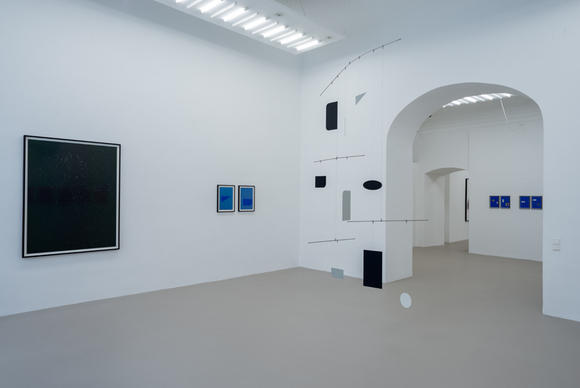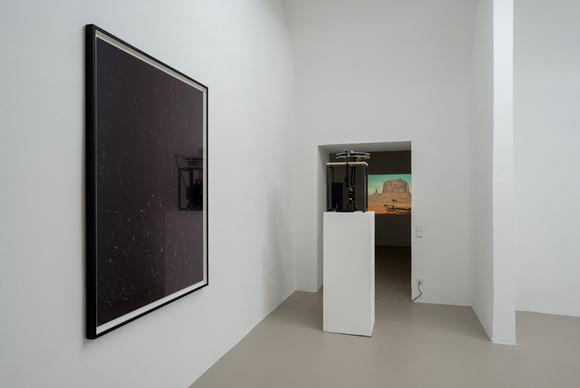"Neue Räume" |
 |
 "Transfer (Monument Valley)", 2016, Film still |
 Exhibition view, Dorit Margreiter, Neue Räume, Charim Wien, Photo: Hannes Böck |
 Exhibition view, Dorit Margreiter, Neue Räume, Charim Wien, Photo: Hannes Böck |
As implied by its title, “Neue Räume” (New Spaces) is the first show to take place in this newly refurbished space. Moreover, it is the first exhibition of Dorit Margreiter’s work at the gallery. These simple conditions led the artist to conclude that this blank slate is an artistic equivalent to that of a frontier, therefore requiring her to revisit the history of the Western genre. The result of this dryly hilarious reasoning, underpinned by her erudition in cinema history, is a short 16-mm film featuring a lone rider and his horse in a sublime landscape, titled Transfer (Monument Valley), 2016. Shot at John Ford Point in Monument Valley, Arizona, this film is both the centerpiece and the synthesis of the exhibition, which otherwise features a collection of works produced since 2015 spread across four rooms. Each element in the film nods to the central subjects of other pieces, including the nature of filmmaking, the sun, and equestrianism, just to name a few.
This show is bracketed by Experimental Noise (No.8) and Experimental Noise (No.9), both 2015. At first glance, these two large photographs seem to be pictures of a starry sky. However, they are in fact wholly digitally produced images that re-create the appearance of scratched and dirty film. These are essentially Photoshop filters that produce the effect of damaged photo negatives. Within their minimal visual language, they contain a poignant rebuke of both flawless digital images and the trend for tastefully aged and distressed products. More important, they point to the central concern of Margreiter’s practice: the act of image production and its attendant historical circumstances.
This show is bracketed by Experimental Noise (No.8) and Experimental Noise (No.9), both 2015. At first glance, these two large photographs seem to be pictures of a starry sky. However, they are in fact wholly digitally produced images that re-create the appearance of scratched and dirty film. These are essentially Photoshop filters that produce the effect of damaged photo negatives. Within their minimal visual language, they contain a poignant rebuke of both flawless digital images and the trend for tastefully aged and distressed products. More important, they point to the central concern of Margreiter’s practice: the act of image production and its attendant historical circumstances.
OPENING :
Tuesday, 31.05.2016, 7 p.m.











